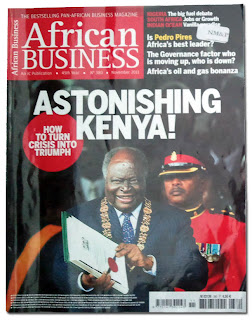
Kwale, one of Kenya’s poorest counties, is sitting on mineral wealth worth billions of shillings.
And now with plans for the commercial exploitation of titanium, niobium and rare earths, there is optimism that the fortunes of the county and its people will get a huge boost.
Experts say the combined value of the minerals is nearly Sh350 billion.
After 17 years of protests, inquiries and reports, the stage is finally set for titanium mining by an Australian company.
And two South African firms have been given the greenlight to explore for niobium and rare earths in the region.
For titanium, all government approvals have been granted and the building work will begin this month, according to officials of the mining firm,
Base Titanium Ltd.
read more at source: http://www.nation.co.ke/Counties/High+hopes+in+Kwale+as+mining+giants+get+down+to+business/-/1107872/1270066/-/10ign2fz/-/index.html
Project Status
Following an extensive due diligence exercise and the securing of approval from the Government of Kenya, Base completed the acquisition of the project from
Vaaldiam Mining Inc (formerly Tiomin Resources Inc) (“Vaaldiam”) in July 2010. Vaaldiam had spent 15 years and in excess of US$60 million progressing the project through resource definition, development of a Definitive Feasibility Study (“DFS”) and government approvals.
The Project has in place a full suite of licences and permits required for development, including a Special Mining Lease, an Investment Agreement with the Government of Kenya and an Environmental Impact Assessment (“EIA”) licence, with the following exceptions. The authorisation to construct the Mukurumudzi Dam, which the Project has held for the past 3 years, is currently subject to renewal. Final approval for 5 boreholes in the Gongoni Forest is also pending. All requirements for the issue of these permits have been met and their issuance is expected in the near future. As a consequence of the change in concept in some aspects of the Project design in the EDFS, EIA Addenda reports are currently being prepared and their approval sought. Due to the nature of the changes, these approvals are expected as a matter of course.
The resettlement program has been completed, with all former landowners and squatters compensated and relocated from the SML to newly allocated land. A small number of farmers who occupy land to be impacted by the ultimate construction of the Mukurumudzi dam have been allocated new land plots but are yet to be relocated and compensated although the formula for doing so has been established.
The Project continues to enjoy a high level of Government and community support. Importantly, the Government of Kenya regards Kwale as a project of national significance and, as such, is committed to seeing its development.
source: http://www.baseresources.com.au/projects/kwale-mineral-sands-project/project-status/
Kenyan exploration projects
Base has acquired an option to purchase three further exploration projects from Vaaldiam, Mambrui, Kilifi and Vipingo. These projects, which are located along the coast to the north of Mombassa, have a combined
JORC compliant Mineral Resource as previously reported by Vaaldiam, of 1,388 million tonnes.
 FYI
Titanium
FYI
Titanium
A strong, low-density, highly corrosion-resistant, lustrous white metallic element that occurs widely in igneous rocks and is used to alloy aircraft metals for low weight, strength, and high-temperature stability. Atomic number 22; atomic weight 47.87 melting point 1,660°C; boiling point 3,287°C;
Read more: http://www.answers.com/topic/titanium#ixzz1dI4FVKtr
Applications of titaniumTitanium is used in steel as an alloying element (ferro-titanium) to reduce grain size and as a deoxidizer, and in stainless steel to reduce carbon content. Titanium is often alloyed with aluminium (to refine grain size), vanadium, copper (to harden), iron, manganese, molybdenum, and with other metals. Applications for titanium mill products (sheet, plate, bar, wire, forgings, castings) can be found in industrial, aerospace, recreational, and emerging markets. Powdered titanium is used in pyrotechnics as a source of bright-burning particles.
source: http://en.wikipedia.org/wiki/Titanium
Niobium

A silvery, soft, ductile metallic element that occurs chiefly in columbite-tantalite and is used in steel alloys, arc welding, and superconductivity research. Atomic number 41; atomic weight 92.906; melting point 2,468°C; boiling point 4,927°C.
Read more: http://www.answers.com/topic/niobium#ixzz1dI6g9E1C
Applications of niobium
It is estimated that out of 44,500 metric tons of niobium mined in 2006, 90% was used in the production of high-grade structural steel, followed by its use in superalloys. The use of niobium alloys for superconductors and in electronic components account only for a small share of the production.
source: http://en.wikipedia.org/wiki/Niobium
Rare earth

Any of the abundant metallic elements of atomic number 57 through 71. Also called
lanthanide. Despite their name, rare earth elements (with the exception of the radioactive promethium) are relatively plentiful in the Earth's crust, with cerium being the 25th most abundant element at 68 parts per million (similar to copper). However, because of their geochemical properties, rare earth elements are typically dispersed and not often found in concentrated and economically exploitable forms. The few economically exploitable deposits are known as rare earth minerals. It was the very scarcity of these minerals (previously called "earths") that led to the term "rare earth". The first such mineral discovered was gadolinite, a compound of cerium, yttrium, iron, silicon and other elements. This mineral was extracted from a mine in the village of Ytterby in Sweden; many of the rare earth elements bear names derived from this location.
Rare earth pricing
Rare earth elements are not exchange-traded in the same way that precious (for instance, gold and silver) or non-ferrous metals (such as nickel, tin, copper, and aluminum) are. Instead they are sold on the private market, which makes their prices difficult to monitor and track. However, prices are published periodically on websites such as mineralprices.com. The 17 elements are not usually sold in their pure form, but instead are distributed in mixtures of varying purity, e.g. "Neodymium metal ≥ 99.5%". As such, pricing can vary based on the quantity and quality required by the end user's application.
source; http://en.wikipedia.org/wiki/Rare_earth_element





















